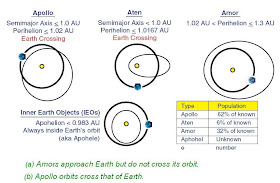
Near-Earth Objects or NEOs are those asteroids that have escaped the confines of the main belt.They roam freely among the planets of the inner Solar System in which Earth is the largest target.Asteroid 433 Eros was the first discovered to have left the main belt and crossed the orbit of Mars.Eros comes within 13 million miles of Earth's orbit. In March 1932, another Mars-crossing asteroid was discovered with a perihelion of 1.08 AU. It was given the name 1221 Amor. It became the prototype Mars-crosser with a perihelion between 1.0 AU and 1.3 AU.
About a month later, another near-Earth asteroid was found but this time with a perihelion inside Earth's orbit. This asteroid was moving very swiftly when discovered, indicating its nearness to Earth.
1862 Apollo was designated the prototype Apollo asteroid having perihelia well inside Earth's orbit. Further observations showed that Apollo actually passed inside the orbit of Venus. Collectively, they were given the name Earth-crossing asteroids.
Both Amors and Apollos still maintain their ties with the main belt, having their aphelia within the confines of the main belt. Inevitably, in 1975, another asteroid was discovered that had entirely broken its ties with the asteroid belt. Its mean distance lay entirely within the Earth's orbit. This asteroid, 2062 Aten, became the prototype for Aten asteroids.

Typical orbits of Apollo, Amor, and Aten asteroids, all of which cross Earth’s orbit. They are collectively termed Near-Earth asteroids. Trojan asteroids occupy very stable positions 60 degrees east and west of Jupiter’s position.
The Hazard
Although chips, hand-sized rocks, and large boulders, all called meteorites, are continually landing on Earth and astronomers find house-sized objects occasionally passing between Earth and the Moon, knowledge of the near-Earth objects, their locations, and physical and chemical characteristics is needed to inventory and assess their hazard potential to the Earth. Disastrous impacts by asteroids and comets have been the popular subject of Hollywood movies, books, newspaper articles, and television shows.

The recognition that a giant asteroid or comet perhaps 10 km across most likely caused the extinction of the dinosaurs in a geological episode known as the Cretaceous–Tertiary Event has highlighted the potential for destruction should an energetic collision occur again. Furthermore, as scientists analyze the energy involved in collisions, they realize that the impacts are tremendous and larger than anything created by human activities (e.g., nuclear weapons) or naturally occurring phenomena on Earth (e.g., volcanoes, earthquakes, or tsunamis). Scientists ponder the results of computer simulations that consider the interactions of colliding objects with various Earth systems both natural and civilized.
Coupled with these computer simulations is the very real phenomenon of the collision of comet Shoemaker–Levy 9 with Jupiter, which was observed worldwide through telescopes in 1994.
The possibly devastating hazard posed to Earth if hit by a high-energy asteroid or comet is now well recognized by scientists and policy makers.One of the objectives of NASA's Deep Impact mission,which sent an impact or spacecraft to collide with comet9P/Tempel 1 in July 2005, was to study a comet nucleus and its interior and to assess the hazard to Earth of impact by a comet. When that analysis is complete, additional basic knowledge of comets will be available to assess what would happen should a new comet be found on a collision course with Earth. The most hazardous cometary impact would be one with a large orbital velocity relative to Earth's.

Cumulative total of discovered near-Earth objects versus time.
Large NEOs are defined as those with an absolute magnitude (H) of 18 or brighter.
Related Articles :
- Sun storm to hit earth with 'force of 100m bombs' in 2012
- Another asteroid hits Jupiter
- Extremely rare Meteorite found in Oregon
- How Much Junk is in Space
- When Giant Black Holes Collide
- Gamma Ray Burst Danger and Studies
Do you like this article? please "Share" and "Like" it to spread the benefit :)...

No comments:
Post a Comment